7 fall fruits and veggies your body needs—plus recipes
Curb your cravings with these healthy meals selected by a nutritionist.
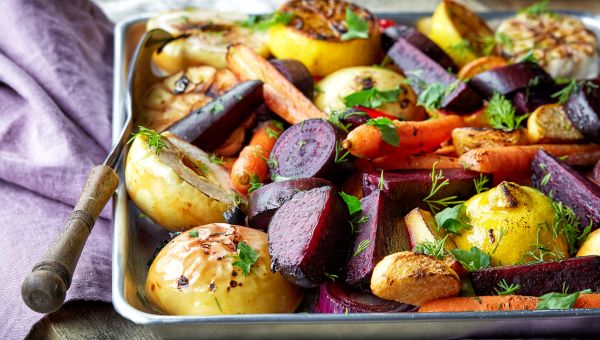
Autumn brings a mix of seasonal fun, like apple picking, family dinners and back-to-school firsts. It also means the end of Daylight Savings, and early sunsets and darker evenings can make most tasks—especially cooking—feel like a chore.
But with an abundance of vegetables and fruits in season, it’s easy to keep your health goals on track during the fall. Kelly Kugler, RD, a registered dietitian and nutritionist in Fort Lauderdale, Florida, shares her favorite produce picks, along with easy ways to prepare them.

Sweet potatoes
The produce aisle in your local grocery store is typically chock full of sweet potatoes from September to March. This versatile fall staple is high in vitamin C; the daily recommended amount is 65 to 90 milligrams, and 1 cup of canned, mashed sweet potatoes contains 67.3 milligrams. They’re also high in fiber, which keeps you regular and helps you feel fuller, longer.
Sweet potatoes are delicious roasted, baked whole or used in soups and stews. In the early days of fall, you can still get away with grilling, which is also a great way to cook them.
For a side dish that feels indulgent—but isn’t—try sweet potato fries. Start by cutting the potato diagonally into long, thin strips, says Kugler, keeping the skin on because the peel contains many nutrients and fiber. Toss with a little olive oil and place the strips directly on the grill. Keeping an eye on them so they don’t burn, cook until tender or for 10 minutes at 400 degrees Fahrenheit. Don’t have a grill? Spray a cookie sheet with non-stick cooking spray and roast the lightly oiled strips for 15 to 25 minutes at 400 degrees Fahrenheit, flipping once about halfway through. Serve as a tasty lunch or dinner side.
For something a little bit more flavorful, cut sweet potatoes into cubes and spread them out on a piece of tin foil. Sprinkle the potatoes with brown sugar, cumin and cayenne pepper. Bake the sweet potatoes for 25 minutes at 375 degrees Fahrenheit, turning them over occasionally until thoroughly cooked.
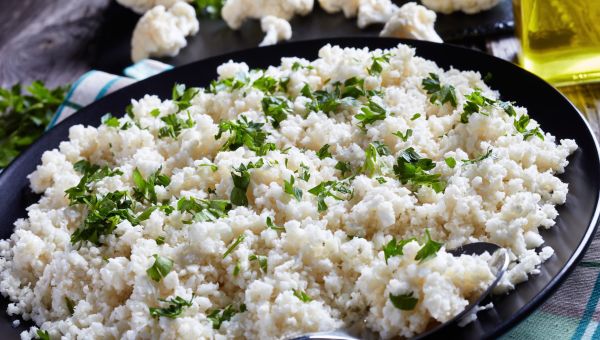
Roasted cauliflower
Cauliflower, in season from June to November, might look boring when you see it at the supermarket, but think twice before you pass it by. Low in calories and high in fiber—1 cup of raw cauliflower contains 2 grams of fiber and only 16 calories—it's a great substitute for foods like rice, bread or even steak.
Cauliflower rice is both trendy and delicious. To rice it, a food processor comes in handy, although finely chopping pieces with a knife or using a grater works as well. Your favorite herb or veggie can also add flavor. First, cut the cauliflower into 1- to 2-inch florets, removing the leaves and the center stalk with a knife. Throw the florets in a food processor and process until finely chopped. Heat a little olive oil in a pan over medium heat, and pour in the riced cauliflower; stir to warm it up. Add chopped jalapeno (seeded if you prefer it mild) or cilantro and a squeeze of lime for zest.
You can also try swapping steak for a roasted head of cauliflower, which are deliciously crispy around the edges and meaty in the center. Simply add spices of your choice and a drizzle of olive oil, wrap in foil and roast in the oven for 15 minutes at 400 degrees Fahrenheit. Then, turn the cauliflower over to the other side and roast for another 15 minutes, or until it’s golden brown.
Cauliflower can be bland on its own, but when you some olive oil and a spice blend, it takes on that flavor and can be a really delicious addition to a meal, says Kugler. Pick blends that don’t contain salts. “Some have misleading names like lemon pepper, but the first ingredient in the blend is salt,” she says.
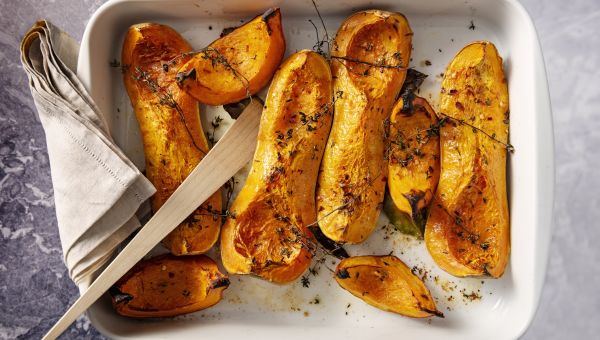
Baked winter squash
Packed with essential nutrients, huge and colorful winter squashes—such as butternut, acorn and Delicata squash—are likely to catch your eye at the grocery store between September and March. Among other vitamins and minerals, they tend to have high levels of potassium, which is essential for healthy blood pressure. The recommended amount of potassium per day is 1600 to 2000 milligrams, and 1 cup of cubed winter squash contains 486 milligrams.
Preparing winter squash might seem intimidating, but these tips can help:
- Poke holes on the outside of the squash with a fork and then microwave it to for three minutes to soften it up, flipping it once or twice during cooking.
- Cut the squash in half vertically with a sharp knife. Remove any seeds and membranes.
- Add a drizzle of oil and some spices like paprika or black pepper to the two squash halves.
- Set the oven to 400 degrees Fahrenheit and roast the squash facedown (so that it doesn’t dry out) on a piece of tin foil for an hour.
- Once the inner flesh is softer and darker, remove from the oven and scoop out the flesh with a spoon.
To make your prep even easier, many stores sells precut squash cubes, which typically roast much faster. Combine the squash with a little olive oil and your favorite herbs or spices for a delicious side dish or salad topper.
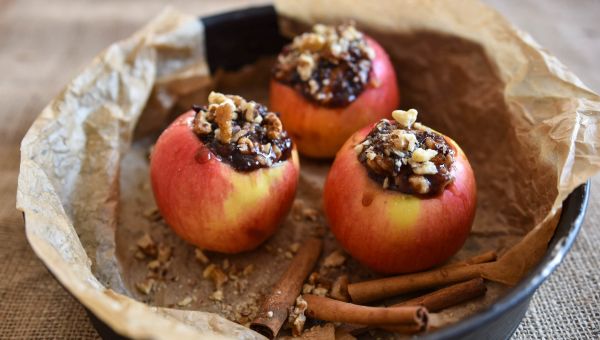
Apples
Trying to curb a sweet craving? Grab an apple. In season year-round—but especially delicious in the fall—apples make a healthy, portable snack that’s a good source of fiber and low in calories. One cup of chopped apples contains 3 grams of fiber and only 65 calories.
For a healthy snack, dip apple slices into a nut butter or low-fat yogurt. If you’re bored of eating apples on their own, blend them in a smoothie.
You can also savor the flavors of fall by whipping up a baked apple. Here’s how:
- Cut out the core of a Gala or Fuji apple using a paring knife or an apple corer, leaving the bottom 1/2 inch of the apple intact.
- Sprinkle the inside with cinnamon, nutmeg and a little bit of brown sugar, then stuff the apple with a mixture of walnuts and cranberries.
- Place in a baking dish, pour in enough water to cover the bottom and cook at 350 degrees Fahrenheit for 20 to 30 minutes.
- For a touch of sweetness, add a light drizzle of maple syrup or honey.
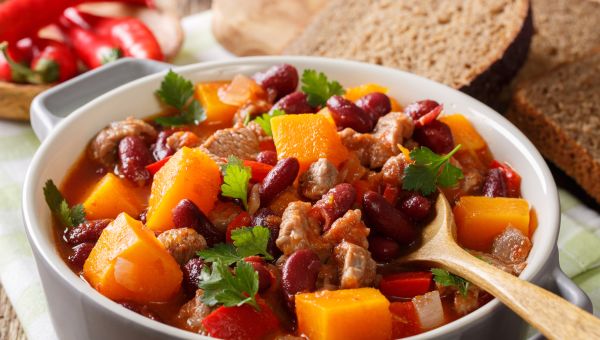
Pumpkins
Pumpkins aren’t just for carving—they’re a healthy source of carbohydrates that you can find at the store or farmer’s market between September and March. The fall veggie only has 0.1 gram of saturated fat per serving.
Pumpkin can be cooked a few different ways. You can roast it, sauté it in chunks with olive oil, or, for a hearty breakfast, add a dollop of pumpkin puree to your oatmeal.
If you’re craving something more satiating, try making pumpkin turkey chili:
- In a large, deep pan over medium-high heat, sauté 1 cup chopped onion, 1 cup chopped green and yellow bell pepper, a little garlic, and a 4-ounce can of diced green chilies for about 10 minutes.
- Add 1 lb. ground turkey and sauté another 10 minutes, until browned.
- Add 1 14-ounce can diced tomatoes, 1 14-ounce can pumpkin puree, and 1 14-ounce can drained and rinsed kidney beans. Stir.
- Add cumin, chili powder, cayenne, salt and pepper to your taste. Stir again.
- Simmer 20 minutes, stirring occasionally. When finished, stir in 1 handful chopped cilantro. Enjoy!
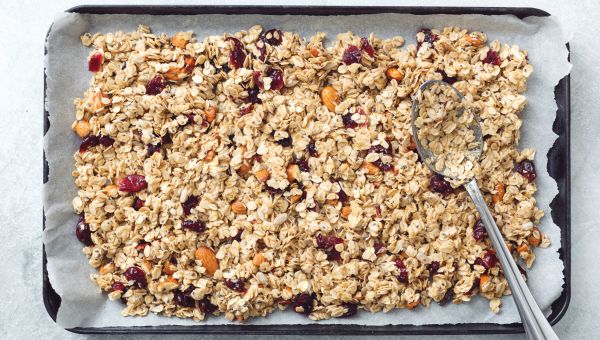
Cranberries
Cranberries are in season just in time for Thanksgiving, from September to December. Berries that are rich in color—like cranberries, strawberries and blueberries—are high in antioxidants and can help slow some of the effects of aging.
One cup of chopped cranberries also contains 14.6 milligrams of vitamin C. It’s especially beneficial to have a vitamin C-rich diet during the fall when there’s a spike in common colds. While the vitamin will not actually reduce the risk of catching a cold, it can help with symptoms.
Want to try your hand at making granola from scratch? Here’s an easy recipe:
- In a large bowl, mix 2 cups of rolled oats, 3/4 cups of wheat germ and some chopped walnuts and dried cranberries.
- In a separate bowl, mix together 3 tablespoons of vegetable oil, 2/3 c honey and a touch of vanilla and cinnamon. Pour over the oat mixture and stir. Spread on a large, ungreased sheet pan.
- Bake for about 35 minutes at 300 degrees Fahrenheit, stirring every few minutes to keep it from burning.
- Once cooled, eat plain in moderation or add to a low-fat yogurt.
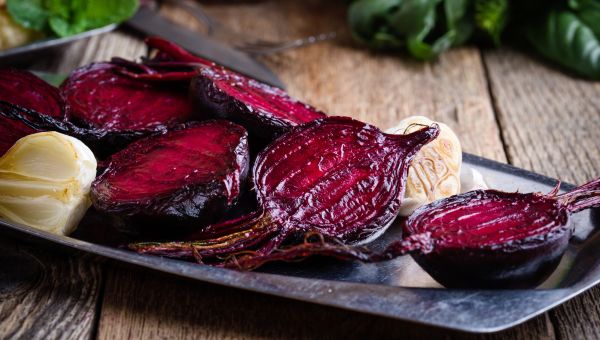
Beets
Beets, in season from June to March, are surprisingly sweet for a vegetable—and they’re nutritious. Beets are filled with nitrates, chemical compounds that dilate the blood vessels, easing the flow of oxygen-rich blood to the heart. Beets are also rich in vitamin C; 1 cup of raw beets contains 6.7 milligrams.
“Sometimes with cooking, less is more,” says Kelly. Beets are one of those vegetables that are loaded with flavor and don’t need much added to them, she explains.
The best way to cut a beet is by chopping off the tops and roots with a sharp knife. Then, peel it with a vegetable peeler. The crimson color of beets will temporarily turn your fingers red, but wearing disposable gloves can protect your hands. Beets can be roasted in chunks, or chopped and sautéed or steamed for 15 minutes until they feel tender. For extra flavor, sprinkle with gorgonzola cheese or a handful of walnuts.

USDA SNAP-Ed Connection. “Sweet Potatoes & Yams,” “Cauliflower,” “Winter Squash,” “Apples,” “Pumpkin,” Cranberries,” “Beets.”
SELFNutritionData. “Sweet potato, canned, vacuum pack,” “Squash, winter, acorn, raw,” “Apples, raw, with skin,” “Pumpkin, cooked, boiled, drained, without salt,” “Cranberries, raw,” “Beets, raw.”
Mayo Clinic. “Is it possible to take too much vitamin C?” “Dietary fiber: Essential for a healthy diet,” “Drugs and Supplements: Potassium Supplement (Oral Route, Parenteral Route),” “Carbohydrates: How carbs fit into a healthy diet.”
NC Sweet Potatoes. “How to Grill Sweet Potatoes.”
AllRecipes. “Roasted Cauliflower Steaks,” “Easy Cranberry Granola.”
Harvard Health Publishing. “Potassium lowers blood pressure.”
S Skrovankova, D Sumczynski. “Bioactive Compounds and Antioxidant Activity in Different Types of Berries.” International Journal of Molecular Science. 2015 Oct; 16(10): 24673–24706.
Holly Larson. “9 Fall Produce Picks to Add to Your Plate.” Academy of Nutrition and Dietetics. September 30, 2019.
Serious Eats. “Healthy & Delicious: Pumpkin Turkey Chili.”
Texas Heart Institute. “Nitrates.”
Laura Jeffers. “Eat Your Beets to Fight Inflammation.” Cleveland Clinic. October 15, 2014.
NIH Office of Dietary Supplements. “Vitamin C.
More On


video
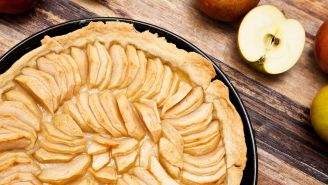
article
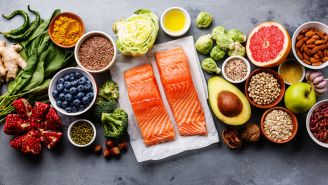
slideshow


video


video
